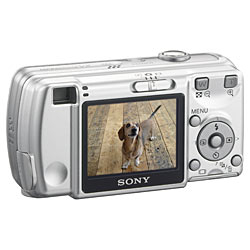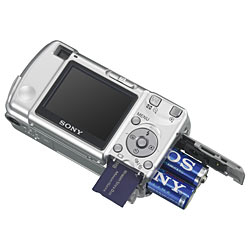
Sony CyberShot DSC-S600
Small is Good
Franco Vitaliano
I was down on one knee, holding this big heavy thing next to my lips, and figured there had to be a better way. It was a zillion pixel digital SLR that some trusting passersby had asked me to use to take their group photo. Maybe this megabuck camera was great for hardcore photo action, but it offended my sensibility for documenting your personal life. You want something compact, inexpensive, easy to store on your person or in your bag, that’s also quick to whip out and get up and running when the right moment hits.
One camera that should be on your short list is Sony’s CyberShot DSC-S600, which retails for less than $200. It sports a hefty 6 megapixels, a Carl Zeiss lens with 3X optical zoom, a wide shooting angle, high sensitivity, and a very strong, room-filling flash. This goodness is all stuffed into an easy to tote 6.4 oz package that’s ready to go in just 1.8 seconds from start-up.

Impressively, the whole shebang runs on inexpensive, standard AA alkalines, good for up to 130 shots, which you can snap every 1.3 seconds, or every 1.8 seconds with the built-in flash. Or it uses optional NIMH rechargeables that will power you all the way to Disney and back, giving you as many as 460 shots of your frolicking grandkids. The entire family can view their Goofy action on the camera’s bright 2-inch LCD screen, which you also use for composing your photos.

If snaps at 1/2000 second can’t slow the kids down enough, the DSC-S600 also takes MPEG movies (VGA, 640x480, up to 30 frames/sec). If that still doesn’t work, try slowing the little darlings with Ritalin. You can then shoot at the other end of the DSC-600’s speed scale, 1/8 of a second. The Sony features a range of digital zoom modes, hanging out all the way to 13x in VGA resolution, or down to 4.1x zoom at a much clearer 3 megapixels, and with a couple of stops in between. White balance modes include auto, daylight, cloudy, fluorescent, and incandescent. Auto redeye removal is also available, as are a variety of pre-programmed scene setups from the camera menu, like Twilight, Twilight Portrait, Soft Snap, Landscape, Beach, Snow, and High Sensitivity.

Unfortunately, this camera doesn’t have a date/time stamp capability, but you could use its built-in microphone and speaker to record and playback the gory details.
The DSC-600 comes standard with 32 MB of memory; effectively useless; so slipping in an optional Memory Stick Duo is mandatory. There is nothing worse than waiting around for memory to recycle before you can snap again, so I’m a great believer in spending as much as you can afford on fast memory. Drop your bills on SanDisk’s new Extreme III Memory Stick PRO, available in 1GB or 2GB capacity (1GB on-line prices, $65 to $100). This memory stick features an astounding minimum18MB per second sequential read and write speed—Plus, it’s certified to work under severe weather conditions. Global warming ain’t gonna slow you down, fellah.
SanDisk also makes a couple of other goodies worth considering. One is their $19.99 MobileMate reader, a thumb-sized USB 2.0 (backwards compatible with USB 1.x) card reader/writer that takes Memory Stick, Memory Stick Duo, Memory Stick Pro, and Memory Stick Pro Duo. It’s perfect for laptops. An alternative is SanDisk’s larger ImageMate USB 2.0 reader ($19.99) that will swallow just about any type of memory card you feed it. You want to use either of these readers when transferring your pix. Why go through the battery-draining hassle of plugging your camera into the computer?
If you do go that laborious route, the DSC-600 will obligingly hookup with PC and Macs via its USB 2.0 port. But note that Sony’s supplied camera software won’t work with Macs, which is no biggie as Apple’s iPhoto works fine. Also note there is no A/V port on the camera (odd, for a Sony) for connecting it to a TV.
So how do the DSC-600’s pictures look? In a word: great. If you are a beginner, or just feeling lazy, leave it in auto mode and get terrific pix. But if so inclined, drop into its menu-driven mode where you can fiddle with a host of items, including flash level. The Sony’s flash is terrific, and easily captures detailed scenes in large, dimly lit rooms. The camera’s ISO sensitivity goes up to 1,000, excellent for this price class, so you can shoot at lower than usual light levels, and you won’t have to worry about losing picture sharpness at slow shutter speeds. (Other ISO modes include Auto, 80, 100, 200, 400, and 800.)
In sum, Sony’s compact DSC-600 takes fabulous snaps day or night, has great flexibility, and costs less than 200 bucks. What more do you want, besides me on bended knee taking your picture?
This article originally appeared in Eons
21st, The VXM Network, https://vxm.com